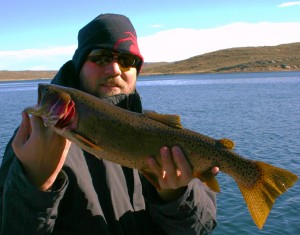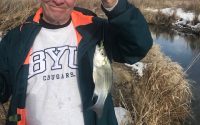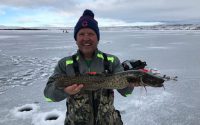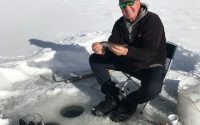Strawberry In The Late Summer And Fall

Bass fishing is my passion, there is no question about it. But, if I can use bass tackle and catch other species of fish — I’m there in a heartbeat. About decade ago I discovered a method for locating and targeting large cutthroat and rainbow trout on Strawberry Reservoir, a trophy trout fishery in north central Utah. Cutthroat trout were planted in the reservoir to curb the ever-growing chub population and of course, as most things with underfunded and overly arrogant DWR (Division of wildlife Resources) biologists, for the first few years the cutthroats found they liked eating triploid, sterile rainbows more than they liked eating chubs –go figure.
It was during those first years that the cuts were growing that I took a chance on fishing for trout just like I fish for bass. Now, before you trollers decide this article isn’t for you, just hear me out. For many years I watched as those who love to troll on Strawberry would put all sorts of contraptions on the ends of their stiff trolling rods and target the rainbows. I always thought it was too much trouble to use such methods but one particular lure they used caught my eye. A long, lifelike rendition of a minnow swimming through the water column at whatever level the down rigger was running seemed to catch a lot of fish. Rapalas were the most popular of those lures and I, usually fishing for trout with cheese and marshmallows or casting a fly and a bubble, was fascinated that the trout would eat such a large presentation.
So, as I furthered my career writing about and fishing for bass, I took the opportunity to try out some of my bass fishing lures on the trout. I did not troll, but treated the reservoir just as I would a bass lake. I studied the points, the bays, the small coves, the structure whether is was grass, weeds, flooded sage brush, rocks, or sand. I noticed the beaver dams, their trails in and out of the water and I quickly determined that if trout were bass, just exactly where they would want to live. I studies their ambush points, behind rocks and in front of grass beds. I explored the backs of coves and bay in shallow water while I imagined a giant bass lurking under the grass mats in the smaller coves and bays.
Finally, after several hours of this kind on intense study, I pulled out a rod with a 5-inch jerkbait (a suspending minnow just like a Rapala) and began throwing my lure to the exact spots I would if I were fishing for bass. Whamm! The first cast was interrupted by a huge strike by an overly-aggressive cutthroat. The fish had been waiting in the exact kind of ambush area I would have expected a bass to be hiding. And, that first strike changed my entire life when it came to fishing on trout waters in the late summer and throughout the fall.
So, from experiment to science, I love my trips to Strawberry starting after Labor Day and continuing through November. I fish for trout just like I fish for bass. I move in and out of small coves and bays, or target long gentle sloping points that jut out into the main lake. I fish all parts of Strawberry but concentrate on areas that have grass beds, rocky points, or a combination of the two.
If I were searching for trout during this time and didn’t want to fish for them as if they were bass, here are a few suggestions.
1. Live on the fish finder. Look for fish in the classic depths — 19 to 35 feet. Look for the fish around point mainly or along vertical walls (in the narrows) where fish might want to suspend while waiting for forage to swim by.
2. Try to get the old days out of your mind. So many anglers want to fish yesterday’s fish. This year, with all the new water, this and almost every other reservoir in Utah is essentially a new lake. Your old spot may now be 10 to 15 feet deeper and the fish have moved away.
3. Don’t be afraid to experiment with your presentations. Far too many anglers fish with the same tired lures for decades. The truth is that flatfish may still work but the advances in tackle development over the years has made those baits rather basic at best and down right ancient and useless at worst. Go smaller and go larger — don’t be afraid to try new things.
4. Pick your poison. If you want to fish for rainbows, look for 35 feet of water in the backs of coves and bays. They won’t school up and concentrate until the water cools some. If you want giant cutthroats go to the points, the rocks or the edges of grass mats and be prepared to only catch a handful of big fish each day. Be satisfied with a few huge fish instead of a dozen slot fish.
I dearly love Strawberry this time of year. I enjoy the challenge of figuring out where the fish are living and what they want to eat. And, the more I explore, the more I research, the more I am convinced that cutthroat trout are just a skinnier version of a big old bass, wanting to ambush their prey and chase down and eat whatever minnow they seek.










